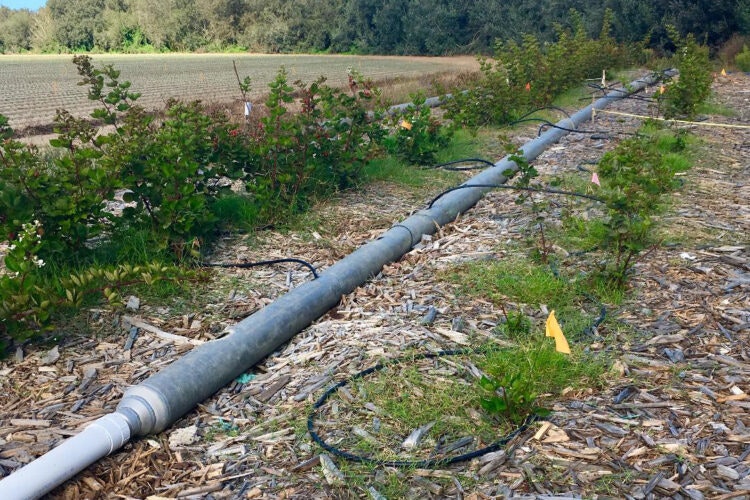De-Nitrifying Woodchip Bioreactors

Bioreactors are a biological tool for improving water quality and are used in agricultural operations to remove nitrates from irrigation runoff. Nitrate residues from fertilizers negatively affect water quality and aquatic life, impairing streams, lakes and the ocean. The Coastal San Luis Resource Conservation District (CSLRCD) has two demonstration woodchip bioreactors within the district.
How a Woodchip Bioreactor Works
- Nitrate-rich water is pumped from the farm into the bioreactor system
- The woodchips host bacteria that break down the nitrates
- This processed water is then slowly released in a discharge location such as in a nearby drainage
- The nitrates, which are broken down by the bacteria on the woodchips, are released as a harmless nitrogen gas
System Requirements
- Lined trench with a carbon source (wood chips)
- Consistent source of nitrate-rich water
- Permissible discharge location
Bioreactor off Los Osos Valley Road
The first bioreactor, after construction in 2015, faces Warden Creek. Field runoff is collected and transported to an underground storage tank (sump). From the sump, water is pumped by a windmill to the wood chips (left of the windmill). Water is detained in the bioreactor basin until nitrate levels have reduced, then a valve gate discharges treated water into the creek.
- 344, 580 gallons of tailwater treated
- 79.1 pounds of nitrates diverted from Warden Creek
Woodchip Bioreactor located near Little Oso Flaco Lake
A second woodchip bioreactor treats agricultural runoff from broccoli fields on the shores of Little Oso Flaco Lake. This system is highly automated, as opposed to its more passive predecessor, with a pump and valve gate system controlled by a timer and, in the future, by nitrate sensors. This bioreactor was planted with commercial blackberries as part of a proof-of-concept project demonstrating that commodity crops (blackberries) can be grown on top of a bioreactor, providing growers a tool to treat on-farm runoff without losing prime agricultural land. The berries thrived, pulling water and excess nitrates from the water in the basin, and when compared with commercially produced varieties, didn’t have elevated levels of nitrates.
- More than 74 pounds of nitrates were removed and 750,100 gallons of water were treated by the bioreactor during this project
- Concentrations of nitrates were reduced by an efficiency of 75 percent and were consistently below drinking water standards

Partners:
CA Dept. of Parks & Recreation, Oceano Dunes District
Landowners
Funders:
CA State Water Resources Control Board
CA Dept. of Food & Agriculture
Natural Resource Conservation District
RCD Contact:
Hallie Richard, hrichard@coastalrcd.org
